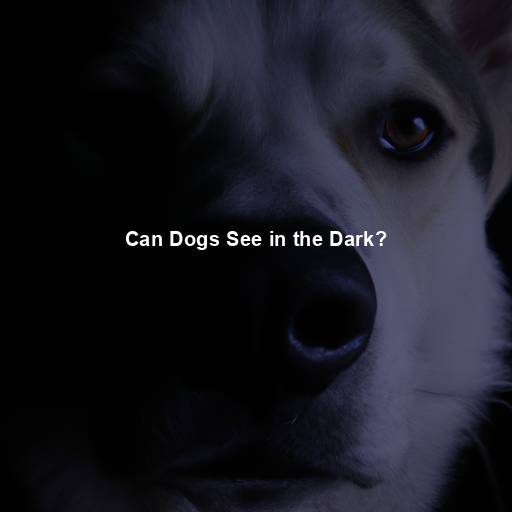Can Dogs See in the Dark?
Last Updated on October 25, 2023 by Evan
Contents [hide]
- 1
- 2 The Anatomy of Canine Eyes
- 3 Adaptations for Low-Light Vision
- 4 The Limitations of Canine Night Vision
- 5 The Role of Other Senses
- 6 Factors Affecting Canine Night Vision
- 7 Supporting Your Dog’s Night Vision
- 8 The Enigmatic World of Canine Night Vision
- 9 FAQs: Does Dogs Can See in the Dark?
- 9.1 Can dogs see in the dark?
- 9.2 How do dogs see in the dark?
- 9.3 Can all dog breeds see equally well in the dark?
- 9.4 Are there any limitations to a dog’s night vision?
- 9.5 Do dogs have better vision than humans overall?
- 9.6 Can dogs see in complete darkness?
- 9.7 Is it necessary to provide dogs with additional lighting at night?
Throughout history, there has been an undeniable allure surrounding dogs, as they exhibit an uncanny ability to astound and charm us with their remarkable senses. The enigmatic question that frequently arises is whether our beloved companions possess the extraordinary ability to see in the dark. As devoted pet parents, we’ve undoubtedly witnessed countless instances when our furry pals effortlessly navigate their surroundings in low-light environments. In this captivating piece, we will embark on a thrilling exploration into the captivating realm of canine vision, aiming to unveil the truth behind the mysterious and ever-gripping question of whether dogs truly possess nocturnal prowess.
Exploring Canine Vision
As we embark on this intriguing journey into the depths of canine perception, let us first unravel the intricate tapestry of how our four-legged friends interpret the world. Just like us, dogs navigate their surroundings using the marvelous gift of sight. But oh, how fascinating it is to uncover the peculiarities that set their visual prowess apart from our own. Through a captivating array of adaptations, these furry beings elevate their instinctual hunting abilities and become the most loyal of companions.
The Anatomy of Canine Eyes
To comprehend whether dogs can see in the dark, it is crucial to examine their eye structure. While similar in basic structure to human eyes, dogs have a few key differences that enhance their visual abilities. One such difference is their larger pupils, which allow more light to enter the eye. Additionally, dogs possess a reflective layer behind their retinas called the tapetum lucidum, which enhances their night vision.
Adaptations for Low-Light Vision
Enhanced Sensitivity to Motion
There is something truly awe-inspiring about dogs and their uncanny knack for navigating the shadows. It’s like they possess a secret superpower, allowing them to detect the tiniest quivers in the darkness. How do they do it, you may ask? Well, the answer lies in their remarkable biology, specifically in their eyes.
Superior Peripheral Vision
Another adaptation that aids dogs in navigating the dark is their superior peripheral vision. While humans have an approximate visual field of 180 degrees, dogs boast an impressive 250 degrees. This wider field of view allows them to detect movement and objects in their surroundings, even in dimly lit environments.
Tapetum Lucidum: The Night Vision Booster
The tapetum lucidum, that reflective layer we mentioned earlier, is what gives dogs their characteristic “glowing” eyes in the dark. This structure acts as a mirror, reflecting light back through the retina and increasing the amount of light available for photoreceptor cells. This amplification significantly enhances their vision in low-light conditions.
The Limitations of Canine Night Vision
While dogs possess remarkable adaptations for seeing in the dark, it is important to note that their night vision is not without limitations. Understanding these limitations can help us have realistic expectations and ensure the well-being of our furry companions.
Limited Color Perception
When it comes to the colorful world around us, dogs might feel like they drew the short end of the stick. Unlike humans who have a rainbow of hues at their disposal, man’s best friend only has a limited color palette. With just two color-detecting cones in their retinas, dogs see the world through a blue-and-yellow tinted lens. And when darkness creeps in, their already limited color perception gets even murkier, leaving them with a rather perplexing view of the world after sunset.
Reduced Visual Acuity
Dogs, our four-legged friends, possess an uncanny talent for detecting movement, but it’s no secret that their eyesight doesn’t quite match up to ours. They might squint and strain to pick up on small nuances or struggle to see things clearly from a distance, particularly when darkness settles in. Nevertheless, these remarkable beings have a secret weapon up their paws – their heightened sense of smell. Through the power of scent, they navigate the world, gathering valuable information about their surroundings.
The Role of Other Senses
Dogs possess an awe-inspiring ability to perceive the world through their eyes, but let’s not forget that their navigation skills are truly a mixed bag of sensory wonders, especially when the lights dim. In their quest to conquer the surroundings, these clever creatures make use of their remarkable scent detection and extraordinary auditory prowess, forming a harmonious symphony of senses that keeps them adaptably triumphant in any setting.
The Power of Scent
It’s no secret that our canine companions have a nose for the extraordinary. Their sniffing prowess bewilderingly surpasses their eyesight, becoming the guiding force in their sensory world. Armed with an impeccable olfactory system, dogs skillfully decipher their environment, track down elusive prey, and gracefully traverse through challenging terrain, even if their vision falters. When darkness envelops the world, their reliance on scent intensifies, an ingenious compensation for the limitations of their night vision.
Sharpened Hearing
Another sense that plays a pivotal role in dogs’ perception of their environment is their hearing. Dogs can detect high-frequency sounds and locate their source with precision. This acute hearing ability enables them to detect potential threats or prey, even in situations where their vision may be impaired.
Sight Hounds: The Masters of Speed and Vision
Breeds like Greyhounds, Salukis, and Whippets belong to the sight hound category. These dogs are known for their exceptional speed and agility, which is closely tied to their visual abilities. Sight hounds have a wide field of vision and an increased number of rod cells in their retinas, enabling them to pursue prey with precision even in dim light conditions. Their slender build and aerodynamic shape contribute to their remarkable speed, making them well-suited for chasing down targets in low-light environments.
Nocturnal Breeds: The Night Owls of the Dog World
Certain breeds have a natural inclination towards nocturnal activities, whether it be due to their hunting instincts or their historical roles as guard dogs. Breeds such as the German Shepherd, Belgian Malinois, and Rottweiler possess heightened night vision capabilities compared to other breeds. These dogs often exhibit a stronger tapetum lucidum, allowing them to excel in low-light conditions. Their keen senses make them ideal candidates for tasks such as night patrols or search and rescue operations.
Working Dogs: Adapted for Various Environments
Working dogs, such as Border Collies, Labrador Retrievers, and Australian Shepherds, have been selectively bred for their intelligence and versatility. These breeds often excel in a wide range of tasks, including search and rescue, herding, and assistance work. While their night vision capabilities may not be as specialized as those of sight hounds or nocturnal breeds, their overall visual acuity and adaptability enable them to function effectively in different lighting conditions.
Factors Affecting Canine Night Vision
Diving into the depths of canine night vision, it becomes a captivating maze of breed-specific quirks and enigmatic influences that unravel the mysteries of their ability to navigate in the darkest of nights. But the tale doesn’t stop there; myriad other factors join the nocturnal performance, transforming it into an intricate dance of visual prowess. By untangling this enigma, we unlock the secret language spoken by each unique furry companion, shedding light on the captivating variances that make them who they are.
As our furry companions gracefully navigate the passage of time, their once keen eyesight, even during the nocturnal hours, may encounter peculiar shifts. The advancing years oftentimes usher in a decline in visual acuity for older canines, making dimly lit environments a bit more befuddling. However, fret not, for diligent veterinary check-ups and vigilant observation can unveil any age-induced alterations in our canine friends’ vision, enabling us to bestow upon them the tailored care and unwavering support they deserve.
Health Conditions
Dogs, just like humans, can experience perplexing health issues that affect their precious sense of sight. It’s a reality we often overlook, but conditions like cataracts, glaucoma, or progressive retinal atrophy can cast a shadow over a dog’s ability to navigate the darkness. Should you spot any peculiar changes in your furry friend’s vision, it’s crucial to seek guidance from a trusted veterinarian who can untangle the mystery and prescribe the right course of action. Their expertise is invaluable in shedding light on this enigmatic situation and ensuring your furry companion receives the care they deserve.
Training and Experience
Dogs, those fascinating creatures of the night, possess an intriguing blend of innate adaptations and acquired skills when it comes to navigating the dark abyss. Their eyes, honed by evolution, harbor a secret power – a hidden realm of night vision capabilities. Yet, it is not solely the mystic forces of genetics that influence their ability to conquer the shadows. The training and experiences they endure, whether as valiant search and rescue dogs or courageous military working dogs, give them an edge in the nocturnal realm.
Supporting Your Dog’s Night Vision
As responsible pet owners, there are certain steps we can take to support our dogs’ night vision and overall eye health.
Regular Veterinary Check-ups
Scheduling regular veterinary check-ups is crucial for monitoring your dog’s vision and detecting any potential issues early on. Your veterinarian can assess your dog’s eye health and provide guidance on maintaining optimal vision.
Proper Nutrition
A balanced and nutritious diet is essential for your dog’s overall health, including their eye health. Providing a diet rich in vitamins A, C, and E, as well as omega-3 fatty acids, can support their vision. Consult with your veterinarian to determine the most appropriate diet for your dog’s specific needs.
Environmental Considerations
Keeping your furry friend safe and at ease while exploring the world after the sun goes down is of utmost importance. Shedding some light on their path with outdoor lighting or equipping them with reflective accessories can work wonders in improving their visibility and minimizing the chances of any unfortunate mishaps. So, gear up and make their nighttime adventures both safe and enjoyable!
Avoiding Harmful Substances
Did you know that some everyday substances can pose a serious threat to your furry friend’s precious peepers? Things like tobacco smoke and those powerful cleaning chemicals we rely on can actually spell trouble for your dog’s delicate eyes. To keep their vision crystal clear and free from irritation or harm, it’s important to create a smoke-free space and opt for pet-safe cleaning products. Your pup’s eyes will thank you for this thoughtful gesture of care.
The Enigmatic World of Canine Night Vision
For ages, humans have been captivated by the remarkable and puzzling skill possessed by dogs for finding their way in the dark. Nature has bestowed upon them a set of fascinating adaptations, including larger pupils and a reflective layer called tapetum lucidum, enabling them to excel in low-light scenarios. Although dogs cannot see in absolute darkness, their mystical visual abilities enable them to thrive and navigate effortlessly in dimly illuminated surroundings. It’s a marvel of nature that continues to puzzle and amaze us.
Understanding the intricacies of canine night vision helps us appreciate the remarkable bond we share with our four-legged companions. So, the next time you embark on an evening stroll with your furry friend or marvel at their ability to spot movement in the dark, take a moment to reflect on the incredible adaptations that make their world a little brighter when the sun goes down.
FAQs: Does Dogs Can See in the Dark?
Can dogs see in the dark?
Dogs have better night vision than humans, but they cannot see in complete darkness. Their eyes are more sensitive to low light conditions due to a higher number of rod cells in their retinas. This allows them to detect movement and objects in dim lighting, making them more adept at navigating in low-light environments than humans.
How do dogs see in the dark?
When it comes to navigating the darkness, dogs have an array of fascinating adaptations up their furry sleeves. Take their retinas, for example. Packed with an abundance of rod cells, these specialized photoreceptors work overtime to catch even the faintest glimmer in low light. But that’s not all – dogs also boast a larger tapetum lucidum, a reflective layer that seems to have been custom-made for enhancing their visual prowess. By bouncing light back into their retinas, this brilliant layer ensures that dogs can make the most out of every dimly lit moment. Mind-boggling, isn’t it?
Can all dog breeds see equally well in the dark?
Dive into the captivating world of canine vision under the moonlit sky! Unveiling the enigmatic variations that lie in the shadows, we embark on a journey brimming with fascinating mystery. From the majestic German Shepherd to the clever Border Collie, certain breeds unveil impressive nocturnal vision, closely guarded by their genetic secrets. Meanwhile, behind the veil of their adorable snub noses, Bulldogs wrestle with dimly lit realms, their eyes delicately woven by the intricate threads of placement and structure. Delve into the captivating tale of darkness and light, as each breed paints a unique portrait in the symphony of the night.
Are there any limitations to a dog’s night vision?
Yes, despite having enhanced night vision, dogs still have limitations when it comes to seeing in the dark. Very dim or pitch-black conditions can still render their vision ineffective. In such extreme darkness, dogs rely more on their other senses, such as their acute hearing and sense of smell, to navigate their surroundings.
Do dogs have better vision than humans overall?
Have you ever wondered how dogs see the world compared to humans? It turns out that our furry friends have some incredible visual abilities that often leave us perplexed. While dogs excel in detecting motion and navigating in low light conditions, humans, on the other hand, have a colorful advantage. With their superior color vision and ability to perceive depth, we humans have a visual experience that is unparalleled. So next time you’re out for a walk with your canine companion, take a moment to appreciate the burst of colors and intricate details that surround you, knowing that your furry friend might be seeing a different picture altogether.
Can dogs see in complete darkness?
Contrary to popular belief, dogs cannot navigate in absolute darkness without any source of light. While they possess remarkable night vision adaptations, they still require a certain level of ambient light to perceive their surroundings. The idea that they can see in complete darkness is nothing more than a perplexing misconception. Without even the slightest glimmer of light, dogs would face an incredibly challenging task in differentiating objects or finding their way around.
Is it necessary to provide dogs with additional lighting at night?
When it comes to our furry friends, ensuring their safety is always a top priority. In the realm of nighttime adventures, shedding light on their path can make a world of difference. Although dogs possess remarkable night vision, a little extra illumination can go a long way in avoiding any unforeseen mishaps. This holds true especially in areas brimming with hidden obstacles or potential perils that may not be discernible under dim lighting circumstances.







